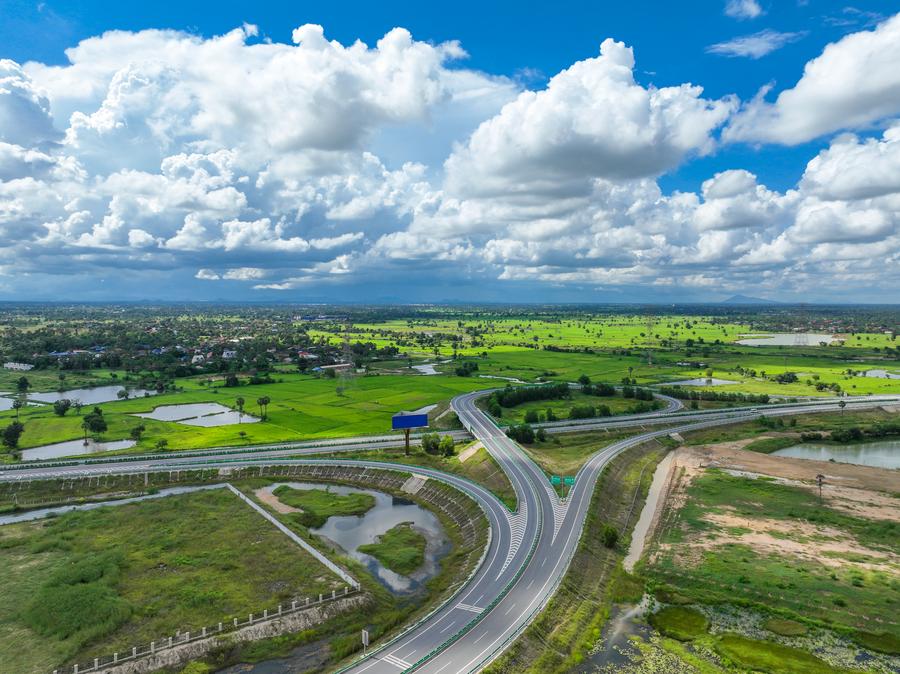China's Belt and Road Initiative catalyses global development
 0 Comment(s)
0 Comment(s) Print
Print E-mail Xinhua, November 14, 2024
E-mail Xinhua, November 14, 2024
An aerial drone photo taken on Sept. 25, 2024 shows a section of the Phnom Penh-Sihanoukville Expressway in Kampong Speu province, Cambodia. (Cambodian PPSHV Expressway Co., Ltd./Handout via Xinhua)
The Belt and Road Initiative has become a new engine of global economic growth, injecting vigorous impetus into building a community with a shared future for mankind.
by Kin Phea
As one of the most ambitious global projects of our time, China's Belt and Road Initiative (BRI) has transformed not only the physical landscape of participating countries but also their economic and diplomatic relationships.
Introduced in 2013, the BRI seeks to enhance global connectivity and cooperation through infrastructure development, trade and investment. It offers a path toward inclusive development and shared prosperity amid rising global challenges, such as trade protectionism and political instability.
BRI's flagship infrastructure projects such as the Sihanoukville Special Economy Zone, the Phnom Penh-Sihanoukville Expressway and the Siem Reap Angkor International Airport in Cambodia, the China-Laos Railway, the Jakarta-Bandung High-Speed Railway, the China-Pakistan Economic Corridor, the China-Europe Railway Express, and the New International Land-Sea Trade Corridor, have been a key driver of trade and economic growth in the region and world.
For Cambodia, the BRI has unlocked significant opportunities for growth, partnership and modernization. It provides a chance to fast-track development, especially through infrastructure improvement, economic diversification, and stronger ties with China.
Infrastructure development has been at the heart of Cambodia's participation in the BRI.
In recent years, significant projects have been completed, reshaping our economic landscape. The Phnom Penh-Sihanoukville Expressway, for example, has boosted transportation efficiency, reducing travel times and improving trade routes.
The new Siem Reap Angkor International Airport has made Cambodia a more accessible destination for tourists and investors.
The Sihanoukville Special Economy Zone highlights how the BRI has driven industrialization in Cambodia. With nearly 200 enterprises and over 30,000 jobs created, it has made a significant contribution to the country's economic growth.
Such projects have helped Cambodia reduce logistics costs, improve competitiveness, and move up the value chain in global trade, aligning with Cambodia's economic aspirations of becoming an upper-middle-income country by 2030 and a high-income country by 2050.
Passengers disembark from a plane at the Chinese-invested Siem Reap Angkor International Airport in Siem Reap province, Cambodia on Oct. 16, 2023. (Photo by Sao Khuth/Xinhua)
Alongside the BRI, trade agreements like the Cambodia-China Free Trade Agreement and the Regional Comprehensive Economic Partnership have opened new opportunities for trade and investment, fueling growth in sectors such as agriculture, manufacturing and technology.
This diversification of trade has created new opportunities for Cambodian businesses and boosted foreign direct investment in critical sectors, helping us reach our long-term economic goals.
An essential aspect of the BRI is its commitment to sustainable development. Through high-quality infrastructure projects, green technology, and initiatives such as the Digital Silk Road, the BRI is not only building bridges and roads, but also driving technological innovation and green growth.
The Digital Silk Road, launched in 2015, focuses on fostering partnerships in telecommunications, 5G and artificial intelligence.
Cambodia has the opportunity to leverage these technological advancements to enhance its digital infrastructure, improving access to education, healthcare and financial services.
With increased digital connectivity, Cambodia can better integrate into the global economy, making our businesses more competitive and our society more connected.
The BRI also aligns with the UN 2030 Agenda for Sustainable Development by promoting projects that are environmentally friendly and socially inclusive.
By embracing green technologies and practices, Cambodia can pursue a development that balances economic growth with environmental sustainability.
The BRI has proven to be a transformative force for Cambodia. It has reshaped our infrastructure, strengthened our economy, and deepened our comprehensive strategic partnership with China.
But the BRI is more than just a development program, it is a blueprint for global cooperation, sustainability and modernization.
As Cambodia looks to the future, our engagement with the BRI will be crucial in achieving our national development goals.
Together, through infrastructure, trade, technological innovation and intellectual collaboration, we can build a more connected and prosperous world.
All in all, the BRI has become a new engine of global economic growth, injecting vigorous impetus into building a community with a shared future for mankind.
Editor's note: Kin Phea is director general of the International Relations Institute of Cambodia, a think tank under the Royal Academy of Cambodia.
The views expressed in this article are those of the author and do not necessarily reflect those of Xinhua News Agency.■




